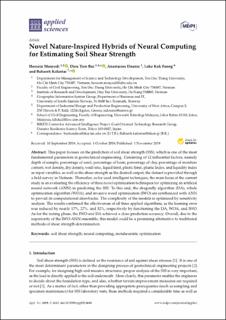Novel Nature-Inspired Hybrids of Neural Computing for Estimating Soil Shear Strength
Peer reviewed, Journal article
Published version
Permanent lenke
https://hdl.handle.net/11250/2646984Utgivelsesdato
2019Metadata
Vis full innførselSamlinger
- Institutt for økonomi og it [152]
- Publikasjoner fra CRIStin [3416]
Sammendrag
This paper focuses on the prediction of soil shear strength (SSS), which is one of the most fundamental parameters in geotechnical engineering. Consisting of 12 influential factors, namely depth of sample, percentage of sand, percentage of loam, percentage of clay, percentage of moisture content, wet density, dry density, void ratio, liquid limit, plastic limit, plastic Index, and liquidity index as input variables, as well as the shear strength as the desired output, the dataset is provided through a field survey in Vietnam. Thereafter, as for used intelligent techniques, the main focus of the current study is on evaluating the efficiency of three novel optimization techniques for optimizing an artificial neural network (ANN) in predicting the SSS. To this end, the dragonfly algorithm (DA), whale optimization algorithm (WOA), and invasive weed optimization (IWO) are synthesized with ANN to prevail its computational drawbacks. The complexity of the models is optimized by sensitivity analysis. The results confirmed the effectiveness of all three applied algorithms, as the learning error was reduced by nearly 17%, 27%, and 32%, respectively by functioning the DA, WOA, and IWO. As for the testing phase, the IWO and DA achieved a close prediction accuracy. Overall, due to the superiority of the IWO-ANN ensemble, this model could be a promising alternative to traditional methods of shear strength determination.
Beskrivelse
Licensee MDPI, Basel, Switzerland. This article is an open access article distributed under the terms and conditions of the Creative Commons Attribution (CC BY) license

